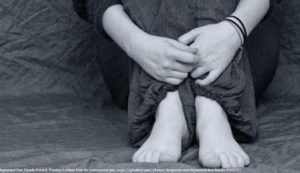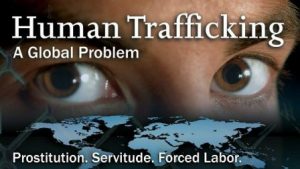Human Trafficking and Migrant Smuggling: The Evil Knows No Pandemic
A joint effort must be made by the national governments, international organisations, civil society and other stakeholders involved to tackle this pervasive evil.
What is the cost of human life? On 27 May 2015, 30 migrants were shot to death by a trafficker in  what is termed as ‘revenge attack’ in Libya. The tragedy occurred in a smuggling warehouse in Mizda, where a group of migrants were being held. Eleven migrants, who sustained severe injuries, were rushed to the hospital. The International Organisation for Migration (IOM) medical staff, who attended them, reported that some of them bear old marks of beating and physical abuse. With the COVID-19 pandemic locking borders, heightening human casualties and causing severe economic strains to the country, victims of TiP (Trafficking in Persons) and SOM (Smuggling of Migrants) are finding themselves more vulnerable to abuse and death. As Federico Soda, the Libya chief of IOM puts it, “(These) criminal groups are taking advantage of the instability and security situation to prey on desperate people and exploit their vulnerabilities.” The pandemic has topped the priority chart of governments and international organisations, and NGOs are severely disabled in assisting the victims of TiP and SOM owing to the restrictions imposed due to the pandemic. There is a need for devising new strategies in response to human trafficking and migrant smuggling to keep pace with these transnational crimes which have already adapted to the new normal.
what is termed as ‘revenge attack’ in Libya. The tragedy occurred in a smuggling warehouse in Mizda, where a group of migrants were being held. Eleven migrants, who sustained severe injuries, were rushed to the hospital. The International Organisation for Migration (IOM) medical staff, who attended them, reported that some of them bear old marks of beating and physical abuse. With the COVID-19 pandemic locking borders, heightening human casualties and causing severe economic strains to the country, victims of TiP (Trafficking in Persons) and SOM (Smuggling of Migrants) are finding themselves more vulnerable to abuse and death. As Federico Soda, the Libya chief of IOM puts it, “(These) criminal groups are taking advantage of the instability and security situation to prey on desperate people and exploit their vulnerabilities.” The pandemic has topped the priority chart of governments and international organisations, and NGOs are severely disabled in assisting the victims of TiP and SOM owing to the restrictions imposed due to the pandemic. There is a need for devising new strategies in response to human trafficking and migrant smuggling to keep pace with these transnational crimes which have already adapted to the new normal.
Human trafficking is defined in the Trafficking in Persons Protocol as “the recruitment, transport, transfer, harbouring or receipt of a person by such means as threat or use of force or other forms of coercion, abduction, fraud or deception for the purpose of exploitation. “The motives behind human trafficking include various forms of illegal profiteering. The Global Report on Trafficking in Persons published by UNODC in 2018, based on the data gathered from 155 countries reveals that the most common form of human trafficking (79 per cent) is sexual exploitation, with the victims being predominantly women and girls. The second most common form is forced labour (18per cent), though the actual number may be higher as the cases of forced labour frequently go unreported. Other motives behind human trafficking include organ harvesting, domestic servitude and forced marriage, slavery and exploitation of children for begging, warfare and sex trade. Migrant smuggling, as defined in the Protocol against the Smuggling of Migrants by Land, Sea and Air, is “…the procurement, in order to obtain, directly or indirectly, a financial or other material benefit, of the illegal entry of a person into a state party of which the person is not a national”. While migrant smuggling is different from human trafficking in that it involves consent of migrants and profit is derived from transportation of migrants to the destination country and not from further exploitation, the line separating both tends to be very subtle and often overlap.
Currently, it is estimated that internationally there are between 20 million and 40 million people suffering under this modern slavery.
However, only about 0.04 per cent survivors of human trafficking cases are identified, meaning that the vast majority of cases go undetected. Hence, assessing the full scope of human trafficking is difficult, which the United Nations refers to as “the hidden figure of crime”. It is estimated that human trafficking earns global profits of roughly USD150 billion a year for traffickers, USD 99 billion of which comes from commercial sexual exploitation.
The data on migrant smuggling too remains scarce. UNODC reports that at least 2.5 million migrants were smuggled in 2016. According to the IOM Missing Migrants Project, there have been more than 3800 deaths during migration around the world in 2015.
Also Read : Need for breaking the deafening silence on Re-Trafficking
The need for a coherent international response to human trafficking and migrant smuggling is highlighted  by its prominent inclusion in the targets of the United Nations (UN) Sustainable Development Goals (SDGs). The IOM (International Organisation for Migrants) and UNODC (United Nations Office on Drugs and Crime) are the leading international organisations coordinating the efforts of national governments, NGOs and other civil society bodies in responding to human trafficking and migrant smuggling. GLO.ACT (Global Action to Prevent and Address Trafficking in Persons and Smuggling of Migrants) conceived in 2015 as a joint initiative by the European Union and the UNODC in partnership with the IOM and the UNICEF, is an important initiative delivering joint response in 13 strategically selected countries across Africa, Asia, Eastern Europe and Latin America. However these programs have to accommodate the recent change in status quo brought by the pandemic.
by its prominent inclusion in the targets of the United Nations (UN) Sustainable Development Goals (SDGs). The IOM (International Organisation for Migrants) and UNODC (United Nations Office on Drugs and Crime) are the leading international organisations coordinating the efforts of national governments, NGOs and other civil society bodies in responding to human trafficking and migrant smuggling. GLO.ACT (Global Action to Prevent and Address Trafficking in Persons and Smuggling of Migrants) conceived in 2015 as a joint initiative by the European Union and the UNODC in partnership with the IOM and the UNICEF, is an important initiative delivering joint response in 13 strategically selected countries across Africa, Asia, Eastern Europe and Latin America. However these programs have to accommodate the recent change in status quo brought by the pandemic.
What is the impact of COVID-19 on responses to TiP and SOM? To begin with, the pandemic has made identification of victims more difficult. With the governments preoccupied in battling the virus, NGOs handicapped and economic life coming to a standstill, the victims are rendered more vulnerable to contracting the virus and have less access to healthcare facilities to ensure their recovery.
The lockdowns have made it easy for traffickers to hide and isolate the victims while economic downturn has aggravated and made more rampant the precarious circumstances that exposed people to human traffickers and migrant smugglers.
Civil society organizations have already issued alerts about access to shelters being denied to trafficking victims because of COVID-19, which may lead to re-trafficking. With judicial service limited, police activities diverted to enforce social distancing and officials busy addressing the pandemic, the forlorn victims are pushed to further desperate circumstances.
Also Read : Anti-Trafficking Bill 2018: A Bone of Contention
These challenges posed by the pandemic were addressed in the recent webinar hosted by GLO.ACT Bangladesh, along with UNODC and IOM, on 11 June 2020.Mia Seppo, UN Resident Coordinator in Bangladesh drew attention to elephant in the room, stating that “the COVID-19 world has further magnified the inequalities and vulnerabilities.” Her opinion was shared by George Gigauri, Chief of Mission in Bangladesh, who pointed out how the impact of pandemic is harshest for those groups who were already in vulnerable situations prior to the crisis. The importance of a human rights and gender-sensitive approach was also reiterated by several speakers, including Nasima Begum, NDC, Chairman, National Human Rights Commission, Bangladesh, who said; “human rights must be at the centre of the response to the COVID-19 pandemic. Inclusive measures aimed at protecting the rights and health of the whole population, including all migrants and trafficked persons, regardless of their migration status, are urgent and necessary.”
To conclude, while there is no questioning of the importance national governments and international organisations have accorded to battling COVID-19, it should be kept in mind while devising the battle strategies that the worst affected by the pandemic are the most vulnerable sections of society. This is important for India too, since it continues to be a top destination for human trafficking in South Asia with people being trafficked mainly from Nepal and Bangladesh. According to National Crime Records Bureau data, there were 38,503 identified victims of human trafficking in India between 2011 and 2019, but a much larger number continues to be trapped in their miserable existences. This draws a parallel with the stories of many Indian migrants, especially in Middle East countries, who are tied to exploitative labour and lack political and legal rights abroad. A joint effort must be made by the national governments, international organisations, civil society and other stakeholders involved to tackle this pervasive evil.
